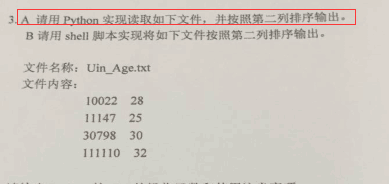Python 中的sort()排序
2018-03-29 19:38
120 查看

v = [1, 3, 5, 2, 4, 6] v.sort() print(v) # [1, 2, 3, 4, 5, 6] v2 = [(1, 2), (2, 2), (2, 3), (3, 1)] v2.sort() print(v2) # [(1, 2), (2, 2), (2, 3), (3, 1)] v3 = [(1, 2), (2, 2), (2, 3), (3, 1)] v3.sort(key=lambda x: (x[1], x[0])) print(v3) # [(3, 1), (1, 2), (2, 2), (2, 3)]
面试题:

1:
sorted_lines = sorted(open("Uin_Age.txt"), key=lambda x: (x.split()[1]))
for i in sorted_lines:
print(i,end='')
2:
open("output.txt", 'w').write("".join(sorted_lines))
l2 = []
f = open("Uin_Age.txt")
for line in f.readlines():
l = line.split(' ')
l1 = l[-1].split('\n')
t = {"x": l[0], "y": int(l1[0])}
l2.append(t)
l2.sort(key=lambda item: item['y'])
for i in l2:
print(i["x"] + ' ' + str(i['y']))
如果写入文件:
sorted_lines = sorted(open("Uin_Age.txt"), key=lambda x: (x.split()[1]))
open("output.txt", 'w').write("".join(sorted_lines))
相关文章推荐
- leetcode—217. Contains Duplicate 查找双数,python排序sort、sorted,for遍历的范围
- Python排序(sort,sorted)保存原来index
- Python List、Dict等的sort与sorted排序
- python sort、sorted排序技巧
- Python中的排序函数argsort,sort,sorted
- python sort、sorted高级排序技巧(转)
- Python实现二维数组按照某行或列排序的方法【numpy lexsort】
- Python中排序常用到的sort 、sorted和argsort函数
- 在Python中使用sort()方法进行排序的简单教程
- Python中的排序方法(Bubble Sort,Insert Sort,Select Sort,Merge Sort,Quick Sort)
- Python 列表的sort()方法之高级排序
- Python内置函数sorted()和列表方法sort()排序规则不得不说的事
- python sort、sort_index方法(排序)
- python sort、sort_index方法(排序)
- python的排序函数sort,sorted
- Python 列表排序方法reverse、sort、sorted操作方法
- 【python】 sort、sorted高级排序技巧
- python3 对list排序 sort
- 005_011 Python 快速排序 不要使用,尽量使用自带的sort
- sort(key= )排序 分类: python基础学习 2013-07-02 16:50 232人阅读 评论(0) 收藏
